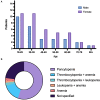Concomitant Hemophagocytic Lymphohistiocytosis and Cytomegalovirus Disease: A Case Based Systemic Review
- PMID: 35514747
- PMCID: PMC9063453
- DOI: 10.3389/fmed.2022.819465
Concomitant Hemophagocytic Lymphohistiocytosis and Cytomegalovirus Disease: A Case Based Systemic Review
Abstract
Background: Hemophagocytic lymphohistiocytosis (HLH) is an immune mediated life-threatening condition. It is driven by an overactivation of the immune system and causes inflammatory tissue damage potentially leading to organ failure and death. Primary HLH is caused by genetic mutations, while secondary HLH is triggered by external factors. Viral infections are a well-known cause of secondary HLH. Cytomegalovirus (CMV) is a virus in the herpes family known to cause HLH in rare cases.
Methods: We report a recent case of CMV-induced HLH, followed by a systematic review of described cases of this rare disease entity, through a structured search in the medical database PubMed. All articles were assessed on a predetermined set of inclusion criteria.
Results: A total of 74 patients (age > 18 years) with CMV-related HLH were identified, 29 men, 42 women, and three patients with unspecified gender. Median age was 37.5 years (range 18-80). Sixty-six patients (88%) had one or more comorbid conditions and 22 patients (30%) had inflammatory bowel disease (IBD), the most frequent comorbidity. Forty patients (54%) received some form of immunomodulating treatment prior to HLH development. The general treatment approach was in general dual, consisting of antiviral treatment and specific immunomodulating HLH treatment approaches. Treatment outcome was at 77% survival, while 23% had fatal outcome.
Conclusion: The findings highlight the importance of early diagnostic work up and treatment intervention. Ability to recognize the characteristic clinical traits and perform specific HLH diagnostic workup are key factors to ensure targeted diagnostic work and treatment intervention for this patient group.
Keywords: HLH; cytokines; cytomegalovirus (CMV); immunosuppression; inflammatory bowel diseases (IBD).
Copyright © 2022 Rolsdorph, Mosevoll, Helgeland and Reikvam.
Conflict of interest statement
The authors declare that the research was conducted in the absence of any commercial or financial relationships that could be construed as a potential conflict of interest.
Figures




Similar articles
-
Hemophagocytic Lymphohistiocytosis Associated With Cytomegalovirus Infection: 5 Cases and a Systematic Review of the Literature.Clin Infect Dis. 2023 Jan 13;76(2):351-358. doi: 10.1093/cid/ciac649. Clin Infect Dis. 2023. PMID: 35974465
-
Tuberculosis-Associated Hemophagocytic Lymphohistiocytosis: A Review of Current Literature.J Clin Med. 2023 Aug 18;12(16):5366. doi: 10.3390/jcm12165366. J Clin Med. 2023. PMID: 37629407 Free PMC article. Review.
-
Hemophagocytic lymphohistiocytosis in inflammatory bowel disease: a nationwide analysis.Ann Hematol. 2023 Jul;102(7):1705-1711. doi: 10.1007/s00277-023-05223-4. Epub 2023 Apr 24. Ann Hematol. 2023. PMID: 37093242
-
Cytomegalovirus pneumonitis-induced secondary hemophagocytic lymphohistiocytosis and SIADH in an immunocompetent elderly male literature review.IDCases. 2020;22:e00972. doi: 10.1016/j.idcr.2020.e00972. Epub 2020 Oct 2. IDCases. 2020. PMID: 33024698 Free PMC article.
-
A Case of Hemophagocytic Lymphohistiocytosis (HLH) Secondary to T Cell Lymphoma and Cytomegalovirus (CMV) Infection and Complicated by Tumor Lysis Syndrome (TLS).Am J Case Rep. 2022 Apr 1;23:e935915. doi: 10.12659/AJCR.935915. Am J Case Rep. 2022. PMID: 35361746 Free PMC article.
Cited by
-
Macrophage Activation Syndrome in Viral Sepsis.Viruses. 2024 Jun 22;16(7):1004. doi: 10.3390/v16071004. Viruses. 2024. PMID: 39066167 Free PMC article. Review.
-
Hemophagocytic Lymphohistiocytosis Triggered by Herpes Simplex Virus 1 and 2: A Narrative Review.Hematol Rep. 2024 Jul 26;16(3):487-503. doi: 10.3390/hematolrep16030047. Hematol Rep. 2024. PMID: 39189243 Free PMC article. Review.
-
Secondary haemophagocytic lymphohistiocytosis in a patient with new-onset systemic lupus erythematosus: the challenges of timely diagnosis and successful treatment.BMJ Case Rep. 2023 Jul 10;16(7):e252938. doi: 10.1136/bcr-2022-252938. BMJ Case Rep. 2023. PMID: 37429644 Free PMC article.
-
Clinical Presentations, Diagnosis, and Genetic Features of Hemophagocytic Lymphohistiocytosis: A Single Institutional Experience With the Saudi Population.Cureus. 2024 Jun 7;16(6):e61879. doi: 10.7759/cureus.61879. eCollection 2024 Jun. Cureus. 2024. PMID: 38978926 Free PMC article.
-
Cytomegalovirus-Induced Hemophagocytic Lymphohistiocytosis in an Immunocompromised Patient with Inflammatory Bowel Disease.Case Rep Hematol. 2024 Apr 2;2024:6964818. doi: 10.1155/2024/6964818. eCollection 2024. Case Rep Hematol. 2024. PMID: 38596354 Free PMC article.
References
-
- Henter JI, Elinder G, Ost A. Diagnostic guidelines for hemophagocytic lymphohistiocytosis. The FHL Study Group of the Histiocyte Society. Semin Oncol. (1991) 18:29–33. - PubMed
Publication types
LinkOut - more resources
Full Text Sources

